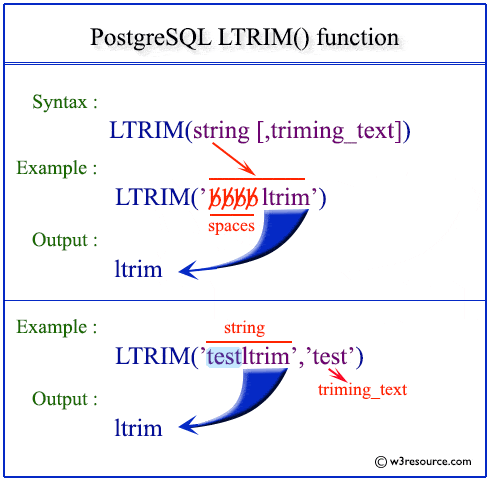PostgreSQL LTRIM() function
LTRIM() function
The PostgreSQL ltrim() function is used to remove spaces ( if no character(s) is provided as trimming_text ) or set of characters which are matching with the trimming_text, from the start of a string.
It is useful for cleaning up or formatting strings by removing unwanted characters from the start.
Uses of LTRIM() Function
- Remove Leading Spaces: Clean up strings by eliminating leading white spaces.
- Custom Trimming: Remove specified characters from the start of a string.
- Data Formatting: Prepare data for consistent formatting by removing unwanted characters from the beginning.
- String Cleanup: Process and clean data entries that may contain leading extraneous characters.
Syntax:
ltrim(<string>[, <triming_text>])
PostgreSQL Version: 9.3
Visual Presentation of PostgreSQL LTRIM() function
Example: PostgreSQL ltrim() function:
In the example below, the statement returns the result 'ltrim'. Here in the example the trimming_text is provided, and it is 'best', and the left four characters i.e. 'test' have removed and the characters 't' and 'e' and 's' are present in the trimming_text 'best'.
SQL Code:
SELECT ltrim('testltrim', 'best');
Output:
ltrim ------- ltrim (1 row)
Example of PostgreSQL ltrim() function with no text:
In the example below, the trimming_text is not provided, so by default the white spaces from the left side of the given string will be removed.
SQL Code:
SELECT ltrim(' ltrim');
Output:
ltrim ------- ltrim (1 row)
Previous: LPAD function
Next: PG_CLIENT_ENCODING function

